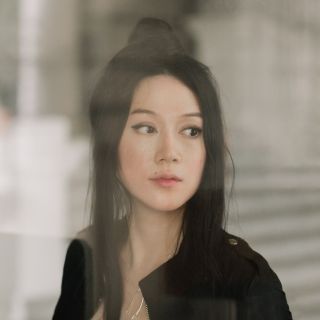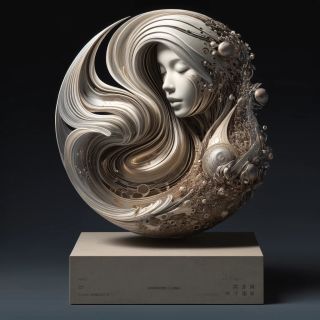Artificial Intelligence
Collectors' Dreams: AI-Enhanced Sculptural Masterpieces
AI's integration into sculpting opens up novel avenues for creativity.
Posted May 31, 2024 Reviewed by Davia Sills
Key points
- Sculpture (along with ceramics) consists of 57 percent of the objects within collections.
- Today, AI-generated as well as traditional sculptures are produced.
- The interaction between artists and AI provides new perspectives on creativity and human expression.
Sculpture (along with ceramics) consists of 57 percent of the objects within collections (Artsy’s Art Collector Insights 2023 report). Despite this, it is a lower-priority art form for some. A new field, however, is about to change that. Enter AI. Its integration into sculpting preserves its essence while at the same time opening up new avenues for creativity and innovation and, thus, new interpretations.
Traditional Sculpture Meets AI
Traditionally, sculptors sketch their ideas on paper or create small-scale models before embarking on the piece. AI tools, however, offer new possibilities for generating and refining concepts. Algorithms can analyze vast historical and contemporary sculpture datasets, identifying patterns and suggesting innovative designs that blend different styles and techniques. The results can be anything the sculptor or collector can imagine.
Generative adversarial networks (GANs)
Generative adversarial networks (GANs), a type of AI, have been particularly influential in the art world. GANs consist of two neural networks—a generator and a discriminator—that work together to create new data resembling the input data. In sculpture, GANs can generate novel designs by learning from existing sculptures, pushing the boundaries of traditional aesthetics.

Robotics Enter the Picture
AI is transforming the design phase and the actual sculpting process. Robotic sculptors equipped with AI capabilities can carve materials with precision and efficiency unmatched by human hands. For instance, the Robotor, an AI-driven robot, can sculpt intricate designs from marble, traditionally associated with classical sculpture. These robots use advanced algorithms to translate digital models into physical forms, ensuring accuracy and detail.
Moreover, AI can assist in physically demanding or hazardous tasks for human sculptors. By automating these aspects, artists can focus more on their work's creative and conceptual elements. This collaboration between human creativity and machine precision exemplifies the potential of AI to enhance, rather than replace, traditional sculptural practices.
Ethical and Philosophical Considerations
The integration of AI into sculpture raises several ethical and philosophical questions. One major concern is the authorship and originality of AI-generated artworks. Who should be credited as the artist if a machine creates a sculpture based on algorithms and data? This question challenges traditional notions of creativity and authorship, prompting a reevaluation of what it means to be an artist in the age of AI.
Additionally, there is the question of AI-generated sculptures' emotional and cultural significance. Art has always been a deeply human endeavor, reflecting its creators' emotions, experiences, and cultural contexts. Can a machine, devoid of human consciousness, produce works that resonate on the same emotional level? While AI can mimic styles and generate aesthetically pleasing designs, the depth of human experience and expression remains a unique aspect of traditional sculpture.

Contemporary Examples
Several contemporary artists and institutions are exploring the intersection of AI and sculpture. For example, the artist Sougwen Chung uses AI to collaborate with robotic arms to create intricate sculptures and installations. Her work blurs the lines between human and machine, emphasizing AI's collaborative potential in art.
Another notable example is the AI-driven project "DREAM," which uses neural networks to analyze dreams and translate them into sculptural forms. This project explores the subconscious mind's creativity, merging it with AI's computational power to create unique, dream-inspired sculptures.
The Future
As AI technology advances, its impact on sculpture will likely grow. Future developments may include more sophisticated AI algorithms capable of understanding and replicating complex artistic nuances. Additionally, advancements in materials science could lead to new mediums for AI-driven sculptures, further expanding the possibilities for artistic expression and thereby giving new opportunities for psychological interpretation.

While AI offers exciting innovation opportunities, preserving the human elements that make art meaningful is essential. The future of sculpture will likely be a harmonious blend of tradition and technology, where human creativity and machine precision coexist.
Summary
AI's ability to enhance the conceptualization, design, and execution of sculptures opens up novel avenues for artistic exploration. As this evolving landscape is navigated, it is essential to strike a balance that honors the rich heritage of sculpture while embracing the transformative potential of AI. Through this synergy, the future of sculpture promises to be even more exciting than before.
References
Elgammal, A., Liu, B., Elhoseiny, M., & Mazzone, M. (2017). CAN: Creative Adversarial Networks, Generating "Art" by Learning About Styles and Deviating from Style Norms—arXiv preprint arXiv:1706.07068.
Bolwerk, A., Mack-Andrick, J., Lang, F. R., Dörfler, A., & Maihöfner, C. (2014). How Art Changes Your Brain: Differential Effects of Visual Art Production and Cognitive Art Evaluation on Functional Brain Connectivity. PLOS ONE, 9(7), e101035. https://doi.org/10.1371/journal.pone.0101035
Editorial: Moral psychology of AI. Front. Psychol., 10 March 2024 Sec. Personality and Social Psychology, Volume 15 – 2024.
Agudo U, Arrese M, Liberal KG and Matute H (2022) Assessing Emotion and Sensitivity of AI Artwork. Front. Psychol. 13:879088. doi 10.3389/fpsyg.2022.879088. Received: 18 February 2022; Accepted: 14 March 2022; Published: 05 April 2022.




